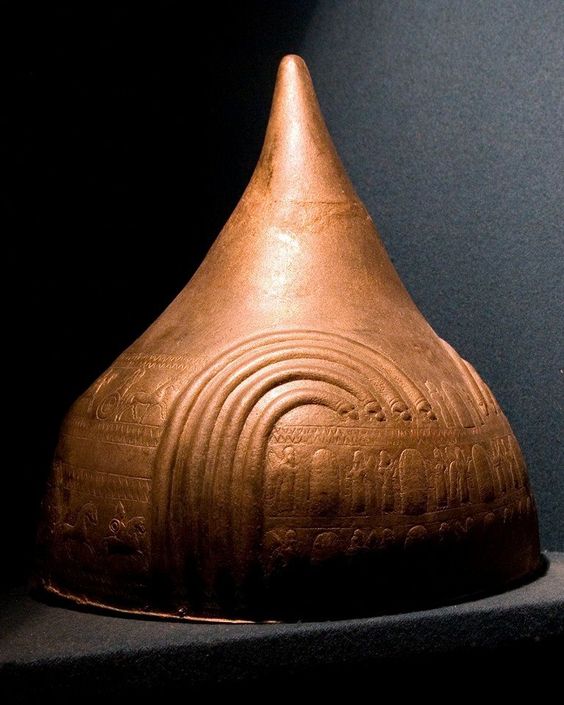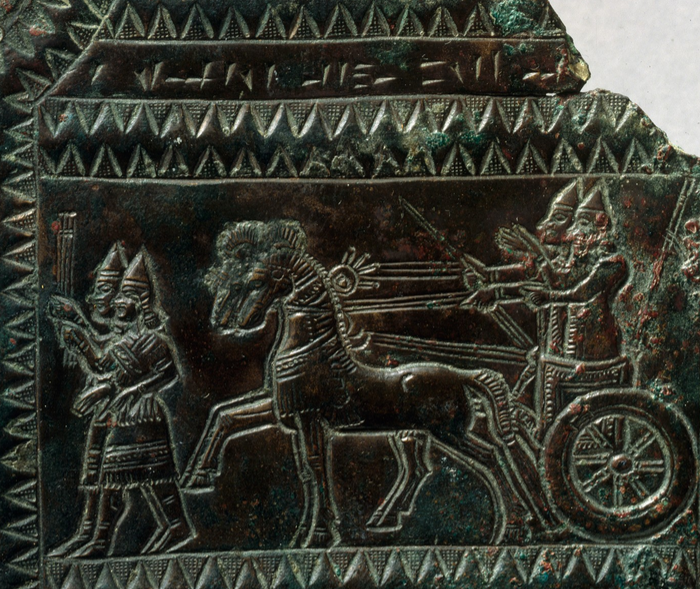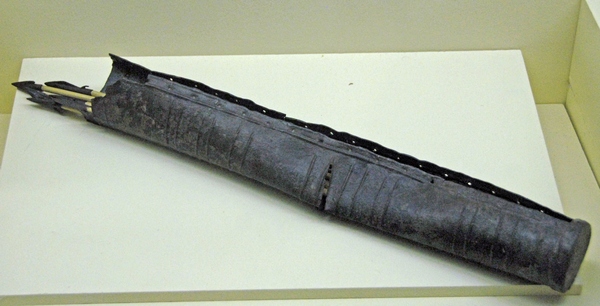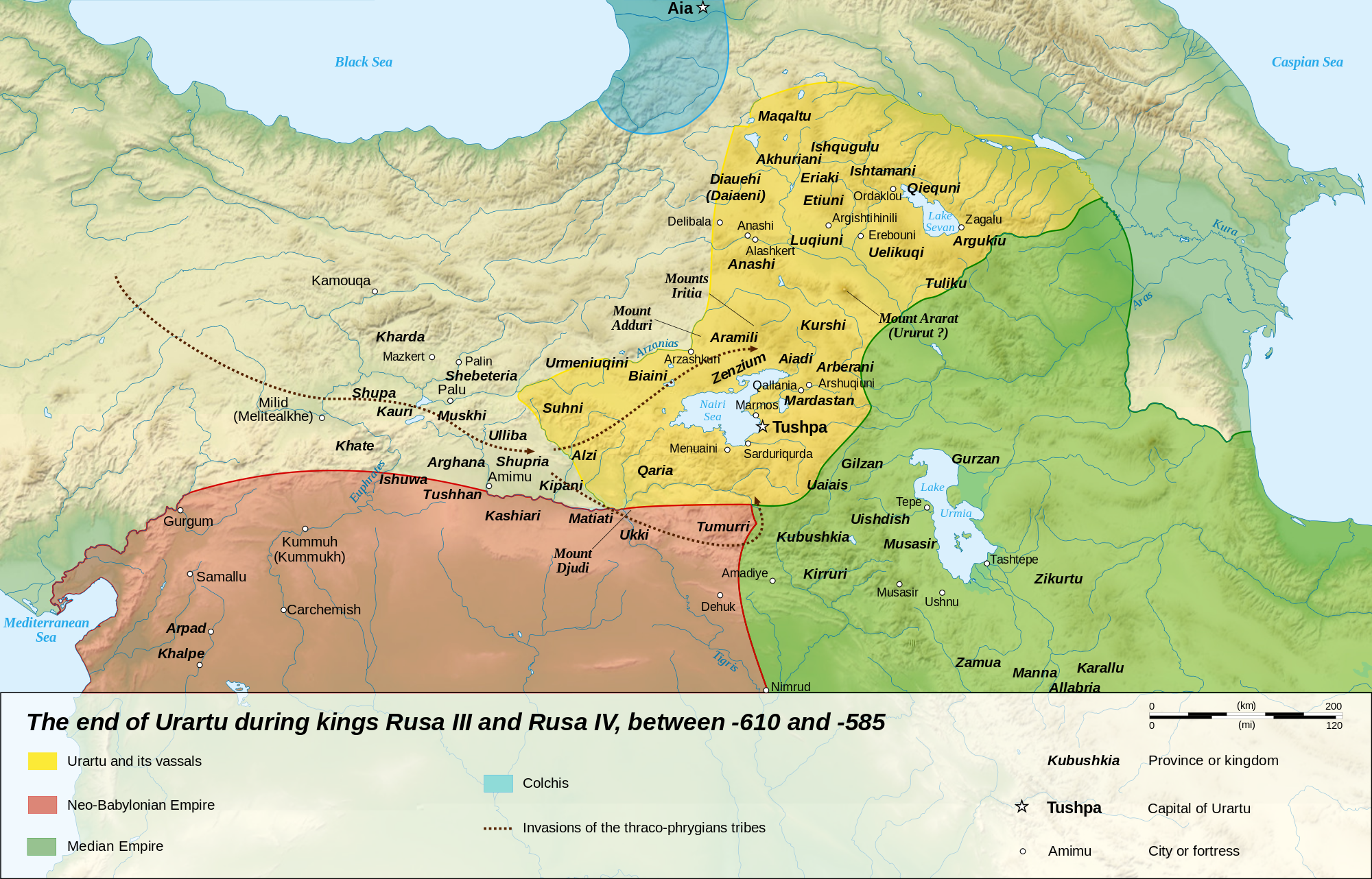History, especially ancient & medieval, usually chose men to be its heroes. Women tend to be held in the background. Armenian history is not any different in that respect, even though there are records of women playing a significant part.
Because Armenia for a majority of its existence has been ruled by kings, history has been silent about Armenian Queens who sat on the throne as royal consorts and influenced sometimes openly and other times subtly the course of events.
In a series of articles, based on Hayk Khachatrian’s book “Queens of the Armenians, 150 biographies based on history and legend”, I will try to shed light on these women, starting with the Queens of the earliest recorded kingdom of Armenia, Urartu, also known as the Kingdom of Van or Kingdom of Ararat.
Queen Araransa
The founder of the Sarduri dynasty of the Kingdom of Van, Sarduri I, the son of Lutipti, ruled from 845 to 825 BC. One day the young Sarduri saw a very beautiful girl in the village of Ulunk, in the province of Hayots Dzor (Valley of the Armenians) and fell in love with her.
After some inquiries he discovered that she was the daughter of a common settler. But his love was so strong that he told his father, Lutipri, about it.
Son, this is not a proper choice for a prince,” King Lutipri objected.
“You cannot marry a country girl, you must find a young lady who has an appropriate status.”
“But I love that girl and I will not marry another woman.”
King Lutipri could not convince his son to abandon his intention. So he had to issue an edict granting the title of prince to the father of the rural beauty. According to the legend, Lutipri later named the girl Araransa and brought her as a bride for his son. And the wife of Sarduri, Araransa, became the queen.
Queen Naira
The king of Van, Ishpuini, inherited the throne from his father, Sarduri l, and reigned from 825 to 810 BC. Ishpuini loved his native country very much and demonstrated this love at the time of his first marriage. After the wedding, the newlywed queen was carried to the royal palace. Here, according to the tradition of Van, the new queen had to set her foot on the ground and cross the threshold of her husband’s home.
But Ishpuini’s wife refused to step down from the carriage and demanded to be taken into the palace on a sumptuous sedan. Ishpuini was enraged and told her: “If you refuse to set your foot on our sacred land, you are not likely to love this land, this palace, and me after becoming the queen. And he ordered the carriage sent back to her father’s home.
Later Ishpuini married a prince’s daughter named Naira, and according to legend loved her so much that in his prayers he always mentioned her name first and asked for her happiness.
Queen Tariria
The king of Van, Menua, the son, and successor of lshpuini ruled from 810 to 788 BC. One of the cuneiform inscriptions that has come down to us mentions the name of the daughter of Menua, Tariria. King Menua planted a vineyard for his daughter and named it Taririakhinele. It was located in Vaspurakan, in the village of Katepants, near the little town of Artamet on the bank of Menua’s canal (later renamed Shamiram’s canal).
Until 1915 this spot was a favorite place of pilgrimage for Armenians from Van. In the inscription, Menua confirms that the vineyard belonged to his daughter, Tariria. From ancient times up until the fourteenth century, the tradition was continued of naming the first son of the king by the king’s name, and the first daughter of the king by the queen’s name.
Assuming that, according to the tradition, Tariria was named after her mother, it can be concluded that the name of Menua’s wife was also Tariria.
Queen Tilama
Sadly not much is known about the Queen Tilama. Perhaps it’s due to the very short reign of her husband King Inushpua. Inushpua, the son of Menua reigned for a very brief period from 788 to 786 BC. An old tale remains about the Queen, mentioning a kind side of the royal, telling that the name of the wife of Inushpua was Tilama. Queen Tilama manifested real kindness to her subjects by suggesting to her husband that royal tax exemptions be provided to the settlers of those villages where at least one of the nurses of the royal infants lived.
Queen Bagena
The king of Van Argishti I, the second son of Menua, succeeded his brother, King Inushpua, and ruled from 786 to 764 BC. History has not recorded the name of the wife who ascended to the throne with King Argishti I. But one tale remains in the memory of Armenians from Vaspurakan.
King Menua summoned his 17-year-old son, Prince Argishti and told him: “Tomorrow the festivities devoted to the gods begin in our capital. All the most beautiful girls from the near and far regions of our country will participate in these festivities. Take a good look at them. The one you like the most will become your bride, the future queen of our kingdom.”
The next day Argishti participated in the festivities and looked at the beautiful girls but did not like any one of them.
“Tell me, which one did you choose?” asked the father at the end of the day of festivities. None of them,” answered the prince with disappointment “Why is it possible that not one of the beautiful girls pleased you?”
“No, father, there was not one that I liked.”
“Son, are you willful or stubborn?”
“Neither one nor the other.”
“Why then can’t you choose a bride?”
“I don’t know.”
“Tomorrow go again to the festivities and look carefully at the girls,” urged the father.
“I doubt that I can give a preference to any one of them.”
“No, my son, it can’t go on like this. You must choose a bride tomorrow. It is not only my paternal demand but also a royal command.” But what if I cannot choose?”
“Then, do the following,” advised the father. “Count the girls and choose the fortieth.”
On the next day, following his father’s advice, Argishti counted the girls he met at the festivities and stopped at the fortieth.
“What is your name?” asked the prince.
“Bagena.”
“I like you. You are the most beautiful girl of all”.
“How did you determine that I am the most beautiful?”
“Because you are the fortieth.” “I don’t understand,” said Bagena.
“Let’s go to my father, and he will explain everything to you,” said Prince Argishti, and taking her hand, accompanied her to his father.
Apparently, this was the only case in Armenian history when a queen was chosen on the basis of arithmetic.
Lucky for us, our parents can’t put a royal demand on us to get married ;).
Queen Susaratu
Sarduri II, son and successor of Argishti as the king of Van, reigned from 764 to 735 BC. An old tale has survived in Vaspurakan about this king’s wife, who was named Susaratu. This splendor-loving queen had the habit of appearing in court wearing a new dress every day. In the capital city of Van several workshops were occupied with sewing the queen’s outfits.
King Sarduri was a wise man. He soon understood that the state treasury was emptying because of huge expenditures on his wife’s finery, adornments, and other luxury items. At the same time, royal troops were not armed well enough and did not have the necessary number of chariots for successful battles against the Assyrian army.
Sarduri stripped his wife of the title of queen and ordered her to keep only two dresses for the rest of her life. Then the king began to spend the wealth in his treasury on armaments, chariots, and supplies for the army. Soon the army began to score victories in battles against the Assyrians.
“If I had tolerated Queen Susaratu’s behavior, she would have destroyed my kingdom with her fineries,” wrote King Sarduri in his memoirs, which have not survived the test of time.
Queen Rusaina
The son and successor of Sarduriu ll, King Rusa I of Van ruled from 735 to 713 BC. We will assume that the name of his wife was Rusaina. It is possible that this was her real name. Legend says that beauty like that of Rusaina might be found only among goddesses. And King Rusa considered his wife Rusaina a sacred woman.
The wife of Assyria king Sargon, who lived during the same time, was terribly envious of Rusaina, so much that she extracted a promise from her husband not only to capture but to kill the Armenian queen. Sargon fulfilled his promise to his wife. In the summer of 714 BC he captured and plundered the temple of Musasir, took as prisoners all the members of King Rusa’s family and ordered Rusaina killed right after entering the temple.
Learning about the horrible death of his adored wife and about the pillage of the temple, Rusa I committed suicide.
Queen Hasis
King Argishti ll, the son, and successor of Rusa I reigned from 718 to 685 Bc. An old tale says that the king’s wife Queen Hasis, was the only woman in the world who within six years gave birth three times, each time to quadruplet boys, for a total of twelve sons. Argishti was very proud and happy. In honor of those great events, he issued an edict according to which all the women who gave birth to multiplets were rewarded with twelve silver coins (based on the number of the king’s sons) from the royal treasury.
Queen Koton
The king of Van, Rusa ll, son, and successor to Argisht ll reigned from 685 to 645 BC. The name of Rusa’ s wife has not reached us. Legend says that the name of this queen coincided with the most ancient name of the river passing through the present-day capital of Armenia, Yerevan. This river originates from Lake Sevan and flows into the River Eraskh. Its present name is Hrazdan, or Zangu. In the remote past the river had the name of lldaruni, and earlier it was named Kodon or Koton. In ancient Armenian “don” (or “ton”) means water, river, or sea. In contemporary Armenian, the word “ton” is used to refer to a heavy rain or downpour.
The well-known expert in cuneiform, Hovhannes Karageozian, has theorized that the five and a half thousand years ago the name of the city of Yerevan was Kodon, taken from the name of the Koton River meaning “sea river” because it originated from the small sea of Sevan.
In the remote past, the Armenians had a tradition of naming their beloved wives by the names of Armenian rivers. Presumably, by naming his wife Koton, Rusa II expressed his great and passionate love for her.
Queen Orash
The son and successor of Rusa ll, King of Van Sarduri III reigned from 645 to 635 Bc. King Sarduri learned that an extraordinarily beautiful girl lived in the village of Khorgom in the province of Hayots Dzor. The king, accompanied by his suite, went to Khorgom, stopped at the home of the local prince and met his beautiful daughter, whose name was Orash. Sarduri supposed that the girl would agree to marry him without any hesitation. But it turned out otherwise. “I will agree to marry you only if you outrun me in a contest,” said Orash.
The young king grinned and agreed to compete with the girl. On the nearest field, in front of the gathered public, the king and the young lady started to run. In the first half of the distance Orash was ahead of the king, but soon the king passed her and won the competition. After this competition the young lady consented to go to the royal court as a bride. But the legend does not end here. The girl kept postponing the wedding. Finally one-day Sarduri said to her: “Orash, I can see that you hesitate to marry me. You keep postponing our wedding, even though l fulfilled your wish. I ran before the eyes of my countrymen as a mere soldier to please you.
“That is right, you fulfilled my wish, but you did not win the contest.”
“What do you mean?” asked King Sarduri.
“No, you did not win, but rather l ost. Let us go to a quiet place far from people’s eyes, and you will see that you did not win the competition.”
They found a suitable place and competed again. This time Orash won “Yes, you won, but why didn’t you win last time?” asked the king.
“I did not want to win because the king must be always the winner before the eyes of his subjects.”
Sarduri was pleased with the girl’s answer and said: “You are not only beautiful but also wise. In a few days, Orash became the queen.
Queen Urania
King Sarduri IV of Van, the successor, and son of Sarduri III ruled from 635 to 625 BC. He was a great patriot and a tail about him confirms this.
The capital, Tushpa, was under Assyrian siege, but the defenders of the city bravely resisted the attacks of the enemy. The siege continued for a very long time and the threat of hunger was real. Panic started to spread among people. Then a rumor arose that the royal court had abandoned the town through a secret passage and that Sarduri no longer expected to stand against the enemy pressure. This would mean that everyone was on his own.
Queen Patar
Argishti III, king of Van, the son, and successor of Sarduri IV, reigned from 625 to 620 BC. A resident of the village of Kharnurd in the province of Hayots Dzor, whose name is Sostenes Grigorian, a 1915 genocide survivor, tells a story about Argishti that he heard from his forefathers. According to that
According to that story, King Argishti had a wife by the name of Patar. To prove her devotion to her husband, she always tasted the food served to the king before letting him eat it.
“Why do you act so?” the royal consort was asked.
“I want to prevent any attempt to poison my husband,” Queen Patar explained, “or if that is not possible, let me be poisoned first and leave this world sooner than my royal husband.”
Queen Tsirané
The king of Van Erimena, son, and successor of Argishti III, reigned from 620 to 610 BC. The wife of Erimin, Queen Tsirané, had an appearance of dazzling beauty. Before her marriage, she had the name of Machanuysh after her father.
When she came to the court, King Eremina told his wife: “Forget your name. We have a tradition in the court to change the name of the king’s bride to one appropriate for our dynasty.
“And what will be my new name?” asked Machanuysh.
“Tsirane,” the king replied. “Tsirani (‘apricot’) is the favorite fruit in our country. Apricot juice is a divine nectar and that’s what our gods drink. They are wiser than humans, they know that the apricot is the only fruit worthy of gods. I want you to bring to me and to our kingdom the flavor of apricots.”
It is said that this tale was carved on a rock near Van, but it scraped in 1916. Unfortunately, in our world, many things connected to Armenia and Armenian history have been wiped out.
Queen Hustan
King Rusa III of Van, the successor, and son of Erimina reigned from 610 to 600 BC. Rusa did not keep a harem and was proud of the fact. He always said that he did no look at any woman in the world but Queen Hutsan, his only love. But in a little while, the queen noticed that her husband was excessively friendly to her maids of honor.
So Hutsan decided to send away all her maids, assuring her husband that she did not need them. One day the queen’s mother said: “My daughter, it does not suit the queen to have no maids of honor.”
“Mother, court life forced me to let them go. Maids of honor have always served as mistresses for kings and l want to keep Rusa from that temptation.”
Maybe that is not a tale but a true story?
Queen Kaputan
The king of Van, Rusa IV son and successor to Rusa reigned from 600 to 590 Bc. The prince of the village Kem in the Armenian province of Vaspurakan had twin daughters, two beautiful girls who resembled each other so much that even their mother could not tell them apart.
The rumor about the beauty of the sisters reached King Rusa, and the young king went to Kem and took both of them as his wives.
“I love you both,” said the king to his twin wives, “but according to the law only one of you can become the queen and her eldest son will be the successor to the throne. Decide yourselves which one of you will be named the queen.”
“No, Your Majesty, it is better that you decide which one of us will be the queen,” said the sisters.
King Rusa pointed to one of them and declared her the queen. He named her Kaputan. He then said to the other sister: “You will remain a respectable court lady with the name of Bal.”
Later on, Rusa distinguished the sisters, Kaputan and Bal, only by the queen’s dress. And nobody knows who actually was wearing the crown. Maybe they put the crown on their heads in turn? The tale ends here with the exhortation: Always keep twins away from a court.
Source:
Queens of the Armenians – 150 Biographies based on history and legend. Hayk Khachatrian, 2001.











